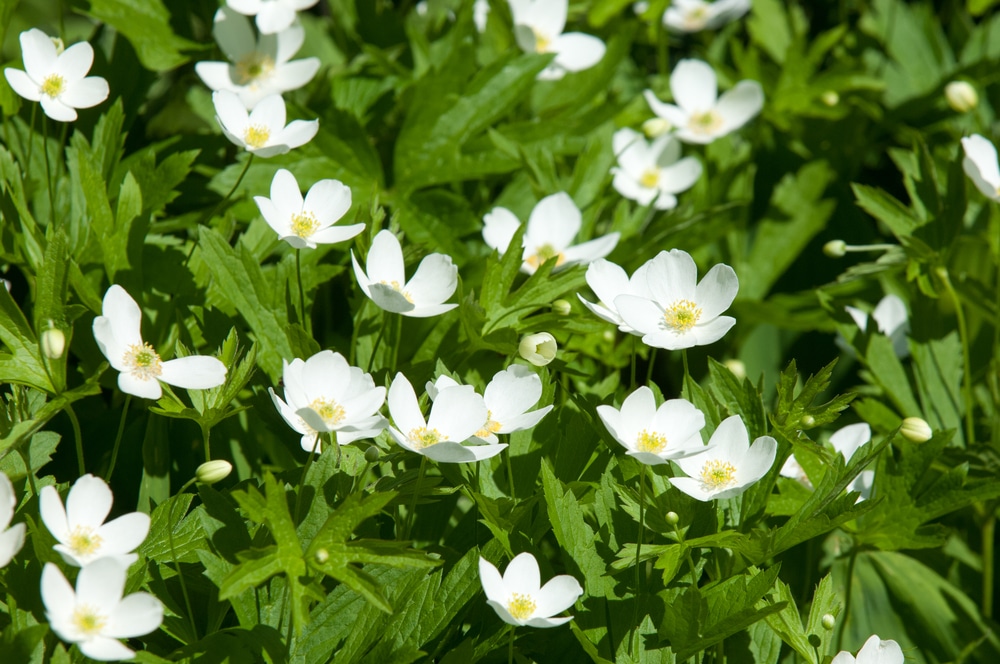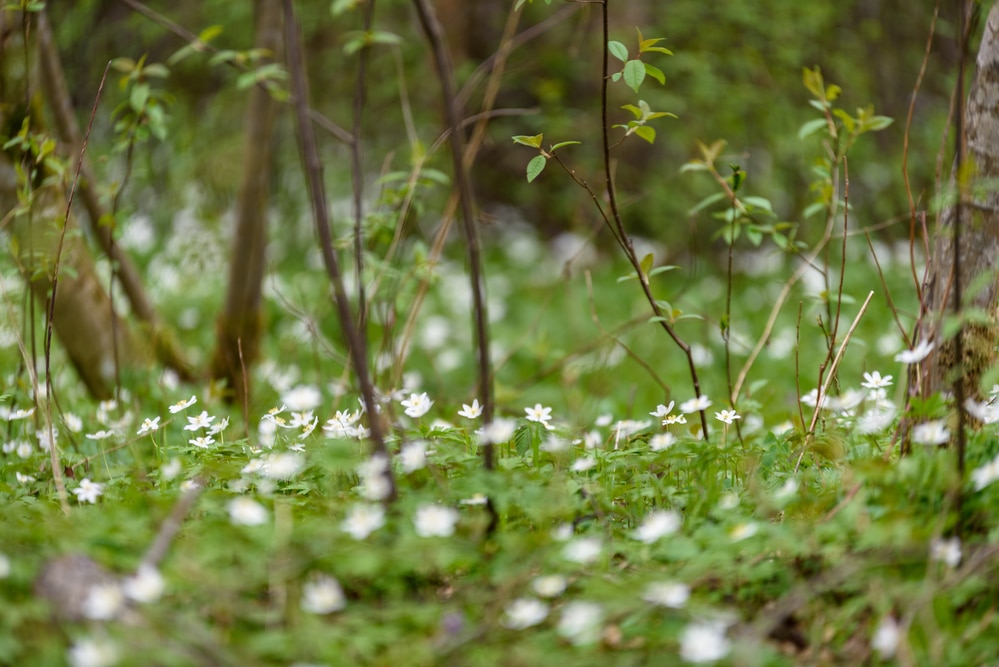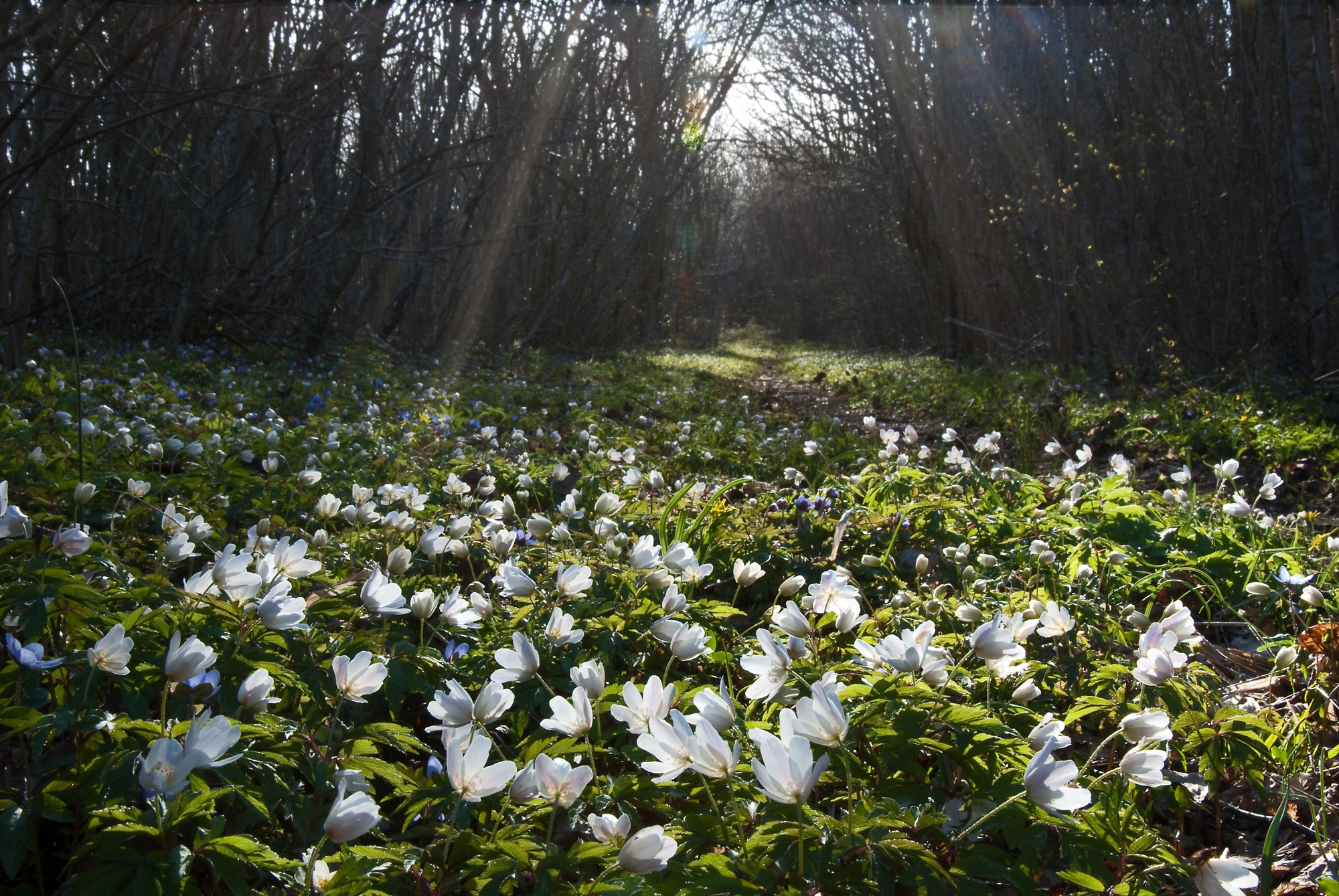Wood anemones (scientific name Anemone nemorosa) are flowers in the Ranunculaceae family, which is in the buttercup family. It grows in large patches or colonies, which can produce a spectacular sight when blooming in large groups. As one steps into deciduous woodland carpeted by the species, over time, the feet are usually enveloped by carpets of flowers.
Wood Anemone goes by many common names, such as haymaids, false windflower, anémone des bois (French), falsa anèmona dei boschi (Italian), and waldanemonen (German).
How To Identify Wood Anemones
Wood anemones are perennials. They grow from rhizomes, which puts up inch-high stems with green leaves and white petals in early spring. In late spring the plant sends up the flower stalks about a foot high with one to five (white flowers) per stalk. The stems and leaves of wood anemone may be hairy or sticky if growing in deep shade and smooth and hairless in sunnier locations. The leaves, however, can be hairless and resemble that of buttercups.

Where To Find Wood Anemone
Wood anemone’s natural habitat is in deciduous woodlands of North America, Asia and various parts of Europe.
It is found in damp meadows and low shrubbery and in soil that is rich in organic matter with lots of sunlight. They often grow in large, loose colonies that cover the ground below them.
This plant prefers high humidity conditions during the summer months when temperatures are warm but not excessively hot. It also grows well in wet soils with lots of mulch or leaf litter around its base.
Wood anemone grows in many different habitats and is often associated with ancient woodland and moist areas. Look for it on the woodland floor and thickets, hedge banks, along stream banks and ditches, marshes and other wet places.

Best Time To See
Wood Anemones are one of the first flowers to bloom in early spring and summer.
Is Wood Anemone Invasive?
No. Studies have concluded that wood anemone is native and not invasive, despite the claims of some authors.
Is Wood Anemone Edible?
Wood Anemones are edible but need to be cooked prior to consumption as they may cause side effects such as nausea, vomiting, itching etc., when eaten raw.
Creatures That Eat It
Wood Anemone is eaten by deer and livestock as well as many other herbivores such as wild rabbits, hares, mice and voles. Many insects also feed on it, including small wasps, flies and bugs that usually lay their eggs inside the flowerhead.
Wood Anemone is a host plant for larvae of some butterfly species such as Painted Lady (Vanessa cardui), which is their primary food source.
The flowers of the wood anemone contain nectar which attracts butterflies, bees, and other pollinators.

Wood Anemone Uses
- Popular in many cultures, the wood anemone has been used for centuries in traditional medicine. Its root contains several bioactive compounds with hepatoprotective, anti-inflammatory, and antioxidant effects.
- In Chinese traditional medicine, it is known as Chu Xiang Hua and is one of the 50 fundamental herbs used within the medical system. It has been reported to have several medicinal properties, including sedative and cardiovascular benefits, amongst others.
- Wood anemone root extracts have been used to treat a wide range of liver diseases, including chronic hepatitis and liver cirrhosis.
- In traditional medicine, it is also believed that they can induce menstruation if eaten in large amounts.
- Used by many European countries, they help prevent soil erosion due to their extensive root system, which binds the soil together with their numerous fibrous roots.
- The plant has been used in the treatment of hepatitis B virus (HBV) infection in China and Korea. It is also effective against autoimmune and inflammatory diseases such as rheumatoid arthritis, chronic obstructive pulmonary disease (COPD), and multiple sclerosis.
Wood Anemones In Art/Culture
It is a popular species in Europe due to its beautiful display when blooming in large groups, which was captured by Vincent van Gogh who reinterpreted its beauty into his painting entitled “Flowers”.
The wood anemone is a popular motif in the art of the Romanesque, Gothic and Renaissance periods. The hare that consumes it symbolises spring and is often associated with Easter, suggesting birth renewal following death.
These woodland plants are also commonly associated with Saint Mary’s Day.
Conservation Status
Wood anemone is widespread across the US, UK and Europe. It is not endangered or threatened.
Sources and References
- Wood Anemone – ywt.org.uk
- Anemone (Wood) – botanical.com
Sam loves to learn about animals and their habitats. He has been a nature lover from a very young age, and has been writing papers and articles about wildlife for as long as he can remember.
